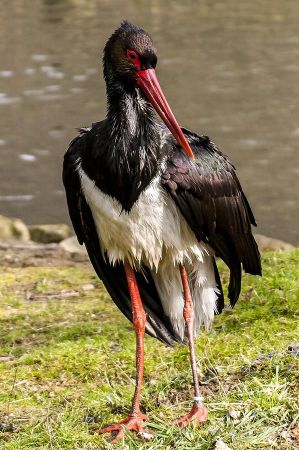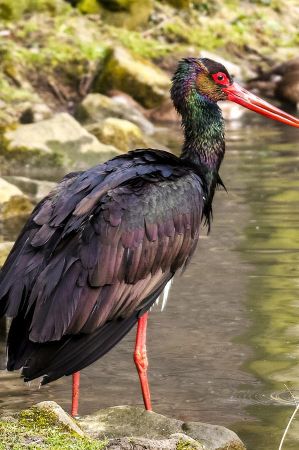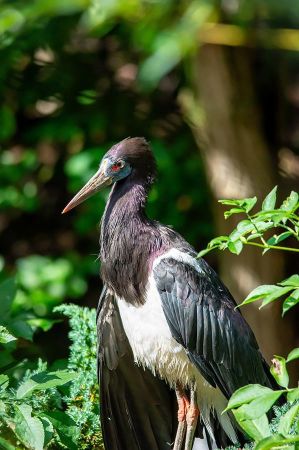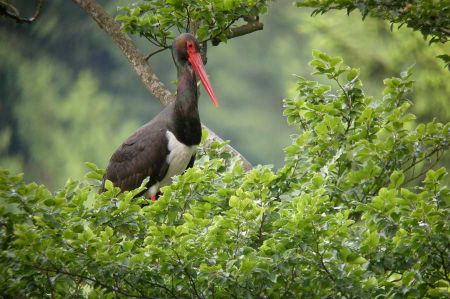Black stork breeds on national natural heritage areas
- Written by Portal Editor
It promises happiness and the blessing of children, is a welcome guest on the roof and is eagerly awaited in spring: When the white stork circles over the house, people are happy.
The black stork, on the other hand, was always the “black sheep” in the stork family. The highly gifted pilot is much more gifted with languages than his monotonously clattering, white “brother”. Although he also uses beak clattering as an instrumental sound, he also has a wide repertoire of loud and quiet calls and songs.
The number of black storks has fallen to eight breeding pairs
 During courtship, especially during synchronized flying and when approaching the nest, a not very loud, melodic, whistling flying sound can be heard, which is varied and modulated in various ways. It can be vaguely reminiscent of the flight call of the honey buzzard. In situations of aggression, this singing element becomes louder, sharper, and sometimes even hisses sharply. In addition, black storks have a wide range of different contact sounds and calls. Beak clattering is either stress or excitement clattering. It precedes copulation and can also be heard in aggressive situations.
During courtship, especially during synchronized flying and when approaching the nest, a not very loud, melodic, whistling flying sound can be heard, which is varied and modulated in various ways. It can be vaguely reminiscent of the flight call of the honey buzzard. In situations of aggression, this singing element becomes louder, sharper, and sometimes even hisses sharply. In addition, black storks have a wide range of different contact sounds and calls. Beak clattering is either stress or excitement clattering. It precedes copulation and can also be heard in aggressive situations.
But he is shy and lives in secret. Its dark, shiny metallic plumage used to often be its downfall. The black stork was associated with mischief, mercilessly persecuted and decimated. The last 700 breeding pairs in Germany are living on the brink of extinction. In Mecklenburg-Western Pomerania, the population of black storks has fallen to eight breeding pairs. “This is a dramatic downward trend,” says Eva Goris, press spokeswoman for the German Wildlife Foundation.
Food and undisturbed breeding grounds for the black stork are rare
 Today the death sentence of the black stork is being carried out on the drawing board: “With the loss of habitats due to the sealing of the landscape, the fate of this rare bird and many other wild animals is sealed. Every day in Germany, wetlands and meadows are lost for settlement and traffic areas,” says Eva Goris. The Federal Ministry for the Environment, Nature Conservation, Construction and Nuclear Safety speaks of 74 hectares per day! In addition, farming in the forests and fields is becoming more and more intensive. Food and undisturbed breeding grounds for the black stork are rare.
Today the death sentence of the black stork is being carried out on the drawing board: “With the loss of habitats due to the sealing of the landscape, the fate of this rare bird and many other wild animals is sealed. Every day in Germany, wetlands and meadows are lost for settlement and traffic areas,” says Eva Goris. The Federal Ministry for the Environment, Nature Conservation, Construction and Nuclear Safety speaks of 74 hectares per day! In addition, farming in the forests and fields is becoming more and more intensive. Food and undisturbed breeding grounds for the black stork are rare.
The “National Natural Heritage” (NNE) initiative is counteracting the loss of habitats in Germany. By taking over 1,200 hectares owned by the Federal Republic of Germany, the German Wildlife Foundation is helping to ensure that “wildlife paradises” are permanently preserved. “A black stork pair is breeding on one of our NNE areas in Mecklenburg-Western Pomerania,” says the press spokeswoman. “We consider this a great success!”
The elegant walking bird needs light, mixed deciduous forests
 Unlike its better-known relative, the white stork, the black stork mostly lives hidden in old, but not too dense, richly structured forests; Deciduous forests and mixed deciduous forests with clearings, streams, pools and ponds are its ideal habitat. Moist, extensively used meadows close to the forest are also part of an optimal black stork habitat. The elegant walking bird needs sparse mixed deciduous forests with streams or ponds to search for toads, fish and insects.
Unlike its better-known relative, the white stork, the black stork mostly lives hidden in old, but not too dense, richly structured forests; Deciduous forests and mixed deciduous forests with clearings, streams, pools and ponds are its ideal habitat. Moist, extensively used meadows close to the forest are also part of an optimal black stork habitat. The elegant walking bird needs sparse mixed deciduous forests with streams or ponds to search for toads, fish and insects.
Old black stork territories are almost always in closed forest areas, usually over 100 hectares in size. With the denser population and the resulting lack of optimal breeding places, breeding settlements have also been found in small forest areas in recent years, and in individual cases even in small fields.
 While the white stork simply places its nest on people's roofs, the black stork needs nesting trees with wide branches and plenty of undergrowth in order to build a solid nest for its offspring. Black storks are very sensitive to disturbance and therefore largely avoid proximity to human settlements; The various claims that the black stork also breeds near human settlements in Transcaucasia have not been supported by recent studies. In 2013, however, in Steppach, Upper Franconia, a nest was built and a brood (two young birds) occurred on a house roof in the centre of the town. The young birds beg extensively with various sounds, some of which sound somewhat duck-like. When threatened, older young storks emit a deep, vocalized sound known to birdwatchers as a bawl.
While the white stork simply places its nest on people's roofs, the black stork needs nesting trees with wide branches and plenty of undergrowth in order to build a solid nest for its offspring. Black storks are very sensitive to disturbance and therefore largely avoid proximity to human settlements; The various claims that the black stork also breeds near human settlements in Transcaucasia have not been supported by recent studies. In 2013, however, in Steppach, Upper Franconia, a nest was built and a brood (two young birds) occurred on a house roof in the centre of the town. The young birds beg extensively with various sounds, some of which sound somewhat duck-like. When threatened, older young storks emit a deep, vocalized sound known to birdwatchers as a bawl.
The black stork is an obligate long-distance migrant throughout most of its large distribution area; only parts of the populations in western Spain and eastern Portugal as well as the South African black storks are resident birds. Like the white stork, the black stork is primarily a thermal migrant, but it crosses the Mediterranean in larger numbers than the latter because it can cover longer distances in flapping flight. The Sahara is mostly flown around on routes close to the coast or only touched on its outskirts. However, a not insignificant number of storks also choose oasis routes and cross the central Sahara.
West mover
Among westbound migrants, around 10 percent choose the Sicily – Cap Bon, Tunisia passage, while the Aegean Island bridge is flown less frequently. As a rule, however, westbound migrants fly over the Mediterranean in the area around Gibraltar. As the species continues to spread westward, the number of westward migrants is also increasing, some of which already overwinter in southern Spain and southern Portugal, but mostly continue on to West Africa, especially to the Niger wetlands and Senegambia.
East mover
 The eastern migrants choose the Bosphorus-Sinai-Nile Valley route and overwinter in East Africa. The wintering areas of the storks that breed in Central Asia are also partly in East Africa and India south of the Himalayas, but mostly north of the equator, while those of the Far East storks are in Indochina and southern China. The Asian high mountains are often flown over; Migrating storks have been observed in the Karakoram at altitudes of 8,000 meters.
The eastern migrants choose the Bosphorus-Sinai-Nile Valley route and overwinter in East Africa. The wintering areas of the storks that breed in Central Asia are also partly in East Africa and India south of the Himalayas, but mostly north of the equator, while those of the Far East storks are in Indochina and southern China. The Asian high mountains are often flown over; Migrating storks have been observed in the Karakoram at altitudes of 8,000 meters.
Every nature lover has the opportunity to take responsibility for a small wildlife paradise by sponsoring an area. “It's not just the black stork that benefits from protected areas: tree frogs, grass snakes and many other wild animals find their wildlife paradise on NNE areas.
“The black stork finds what it needs to survive on our NNE areas,” says Goris.
Please also read:
